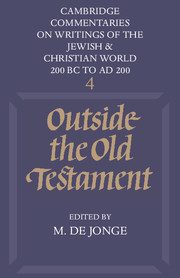Book contents
- Frontmatter
- Contents
- General Editors' Preface
- Editor's Foreword
- Acknowledgements
- Abbreviations
- General Introduction
- Pseudo-Philo, Liber Antiquitatum Biblicarum
- The Ethiopic Book of Enoch
- The Testament of Abraham
- The Testaments of the Twelve Patriarchs
- Joseph and Aseneth
- The Book of Jubilees
- The Testament (Assumption) of Moses
- The Psalms of Solomon
- The Martyrdom of Isaiah
- The Syriac Apocalypse of Baruch
- Paraleipomena Jeremiou
- The Testament of Job
- Index
The Testament of Abraham
Published online by Cambridge University Press: 05 June 2012
- Frontmatter
- Contents
- General Editors' Preface
- Editor's Foreword
- Acknowledgements
- Abbreviations
- General Introduction
- Pseudo-Philo, Liber Antiquitatum Biblicarum
- The Ethiopic Book of Enoch
- The Testament of Abraham
- The Testaments of the Twelve Patriarchs
- Joseph and Aseneth
- The Book of Jubilees
- The Testament (Assumption) of Moses
- The Psalms of Solomon
- The Martyrdom of Isaiah
- The Syriac Apocalypse of Baruch
- Paraleipomena Jeremiou
- The Testament of Job
- Index
Summary
The Testament of Abraham is a Jewish work, probably of Egyptian origin, which is generally dated to the latter part of the first century ad. It is most closely related to the Testaments of Isaac and Jacob, both of which are dependent on it. It has many themes in common with several other works, most notably 2En and 3Bar. It should not be confused with the Apocalypse of Abraham, even though the latter work also describes a heavenly tour (chapters 15–29).
The textual witnesses
TAb exists in two major recensions, and the original text is not recoverable. The longer recension (TAb a) is attested by a great number of Greek manuscripts and supported on the whole by a Rumanian version. The shorter recension (TAb b) is attested by several Greek manuscripts and supported on the whole by the Slavonic version, another Rumanian version, and by the Coptic, the Arabic and the Ethiopic versions. The fullest available list is that given in A.-M. Denis, Introduction aux Pseudépigraphes grecs d'Ancien Testament, pp. 32–4. The oldest extant witness is a fifth-century fragmentary Coptic text (unfortunately still unpublished).
There is considerable disagreement with regard to the earliest form of the work and the relationship between the two major recensions. It seems most likely that the longer recension better reflects the contents of the original work, although the shorter recension may in some cases preserve the earlier wording.
- Type
- Chapter
- Information
- Outside the Old Testament , pp. 56 - 70Publisher: Cambridge University PressPrint publication year: 1986
- 1
- Cited by



